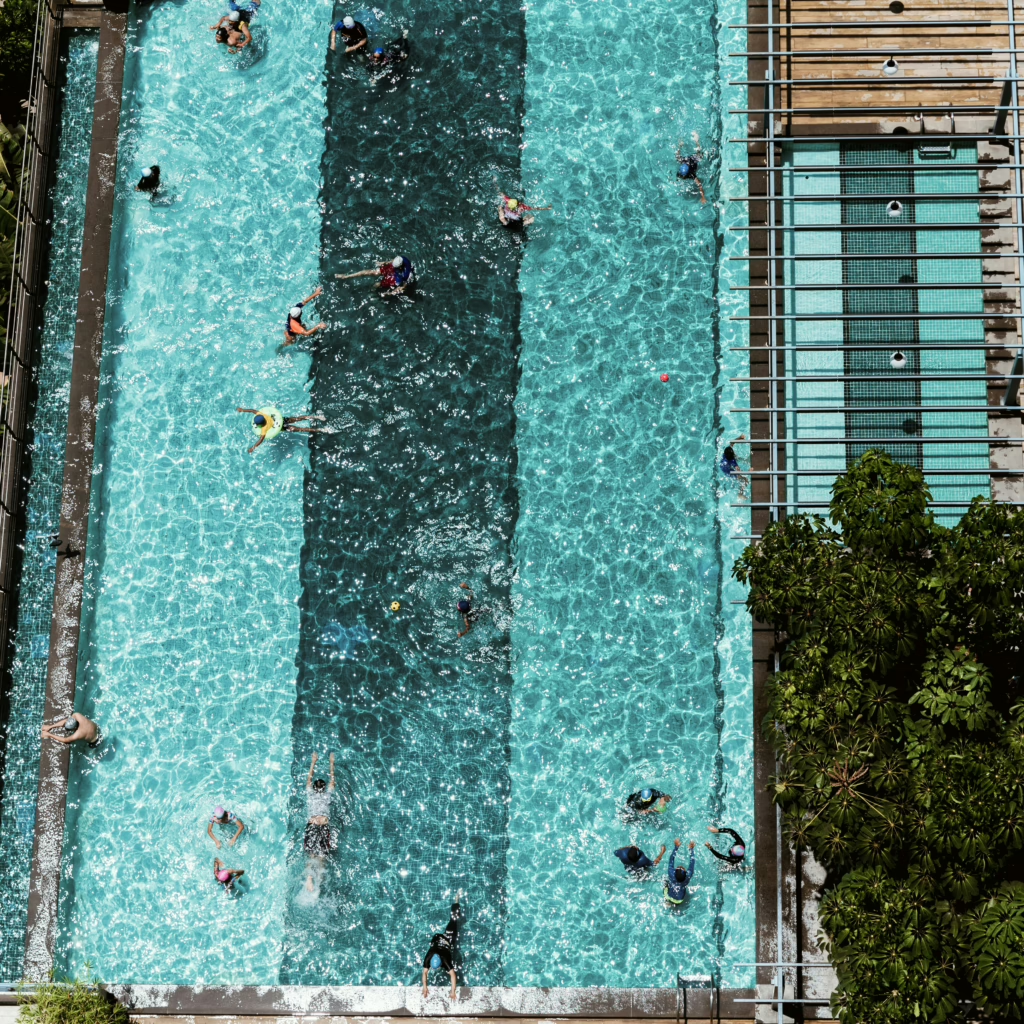Overall, there are three main steps involved in saltwater pool installation: adding the salt chlorinator to the return line, balancing the water chemistry, and then adding the right amount of salt into the water. Below, we’ll break down each of these steps in detail so that you know exactly how to set up a saltwater pool (and after that, we’ll show you how to maintain it as well).
How To Set Up a Saltwater Pool: A 3-Step Process
Saltwater pools eliminate the need to sanitize your water with liquid chlorine or chlorine tablets, as they are able to generate their own chlorine. This is made possible through a device called a salt chlorinator, which uses a salt cell to convert salt into chlorine through electrolysis.
Compared to a traditional chlorine pool, saltwater pools have significantly lower levels of chloramines — and these chlorine byproducts are what cause the ammonia-like odor, dry skin, and red eyes that take a lot of the fun out of swimming in a pool.
So, here’s how you can complete a saltwater pool installation and access these benefits:
Step 1: Install the Salt Chlorinator
There are two types of salt chlorinators: complete salt systems and in-line salt systems.
Both of these systems involve adding a salt cell to the line that returns water from your pump and filter back to your swimming pool. Complete systems have a separate control panel, while in-line systems have a control panel built right into the salt cell.
The installation process depends on which of these types of systems you choose, as well as your system’s particular make and model. It’s easier to set up an in-line salt system, which typically involves the following steps:
- These systems usually come with a template — use this to mark where you’ll need to cut into the return line to make space for the salt chlorinator.
- Use a pipe cutter or hacksaw to make these cuts and remove the section of pipe.
- Slip the provided collars onto each end (make sure they’re facing the right way).
- Apply PVC primer to the ends of the cut pipe and on the inside of the union pieces that came with your salt chlorinator, then apply PVC cement to the same areas.
- Attach the union pieces to each end of the pipe.
- Line up the salt chlorinator with the union pieces and screw the collars on until they are hand-tight.
- Plug the system into a GFCI outlet.
This may be more DIY than you’re comfortable with, though. In that case, you can always hire a professional pool service to take care of the installation for you.
Step 2: Balance the Water Chemistry
Before turning your salt chlorinator on, you need to make sure that certain chemicals in your pool water are all at the right levels. Otherwise, the system might not run properly, or you could even damage it.
Use a liquid test kit or test strip to see where your current levels are at. Then, you can use the following table to determine what your next steps should be:
| Chemical Component | Optimal Level | How to Increase | How to Decrease |
| Alkalinity | 80 to 120 ppm | Baking soda | Muriatic acid |
| pH | 7.4 to 7.6 | Soda ash | Muriatic acid |
| Chlorine | 1 to 3 ppm | Liquid chlorine | Sodium thiosulfate |
| Cyanuric acid | 30 to 80 ppm | Add more cyanuric acid | Dilute pool water |
| Calcium | 175 to 225 ppm for vinyl or fiberglass pool, 200 to 275 ppm for concrete or plaster | Calcium chloride | Soda ash |
Step 3: Add the Salt
Once the rest of your chemicals are properly balanced, it’s now time to add the salt into your soon-to-be saltwater pool.
If you don’t add enough salt, then the salt chlorinator won’t be able to generate enough chlorine to keep your water sanitized (and many systems will simply stop running if there isn’t enough salt in the water). But if you add too much salt, this can cause corrosion that damages your pool components, leading to costly repairs.
Check the manual of your specific salt chlorinator to see what the salt concentration should be. This is usually somewhere between 2,700 to 3,500 ppm.
We tend to aim for a salt concentration of 3,200 ppm (assuming this is within the salt chlorinator’s recommended range). Of course, the amount of salt you need to add to reach this mark will depend on how big your pool is.
Here’s a formula you can use to work this out: take your pool’s volume in gallons and multiply it by 8.35. Also, subtract your pool’s current salt concentration (in terms of the ppm divided by 1,000,000) from 0.0032. The last step is to multiply these two figures together — this will give you the amount of salt you need to add to your pool (in pounds).
For example, imagine you have a 10,000-gallon pool that currently has no salt in it. In that case, you’d first multiply 10,000 by 8.35 and get 83,500. And then 0.0032 minus 0 is 0.0032. The last step, 83,500 times 0.0032, gives you 267.2 pounds of salt. Pool-grade salt typically comes in 40-pound bags, so you would need to add in about six and two-thirds bags.
Notice that this formula also works if you already have some salt in your pool but need to figure out how to raise it into the optimal range.
To demonstrate, let’s say you have a 10,000-gallon pool with a salt concentration of 2,000 ppm. Again, 10,000 times 8.35 is 83,500. The initial salt concentration, 2,000, divided by 1,000,000 is 0.002 — and 0.0032 minus 0.002 is 0.0012. Finally, 83,500 times 0.0012 is 100.2. That means you would need to add about 100 pounds of salt, or roughly two and a half 40-pound bags, to get the salt concentration back up to 3,200 ppm.
Add your salt directly into the pool (don’t dump it in the skimmer). Brush any salt that is collecting at the bottom of the pool to kick it back up into the water, and let your pump run overnight so that the salt circulates and fully dissolves. Then, you’ll finally be ready to turn on the salt chlorinator — and at that point, your saltwater pool will be fully operational.
How Do You Maintain a Saltwater Pool?
While saltwater pools require less maintenance than a traditional chlorine pool, that doesn’t mean they’re completely hands-off. Specifically, here are a few important things to watch out for:
- Keep an eye on your salt levels: The salt in a saltwater pool doesn’t evaporate, allowing it to get recycled back through the salt chlorinator again and again. But your salt level can get lower over time due to splashing, rain, etc. — you may need to top it off about once or twice a year. You can use test strips or a digital salinity tester to determine your current salt levels.
- Keep an eye on your pH levels: Salt chlorinators will raise the pH of your pool water, as the process of converting salt into chlorine also produces a high-pH byproduct called sodium hydroxide. So, test your pH regularly and add muriatic acid to lower it whenever necessary. Reducing the run time on your salt chlorator (it shouldn’t need to run for more than 10 hours per day) can also help alleviate this problem.
- Check your salt cell for calcium buildup: Calcium deposits will form on the metal blades inside salt cells, eventually to the point of blocking your cell from being able to generate enough chlorine. Dissemble your salt cell and check the blades every three months. If you see a significant amount of these white and flaky calcium deposits, you can remove them by soaking the inside of the cell in a solution of two parts water, one part muriatic acid for about ten minutes and then rinsing the cell off with a hose.
Having any issues with your saltwater pool that aren’t addressed here? Go ahead and schedule your saltwater pool repair service today.



